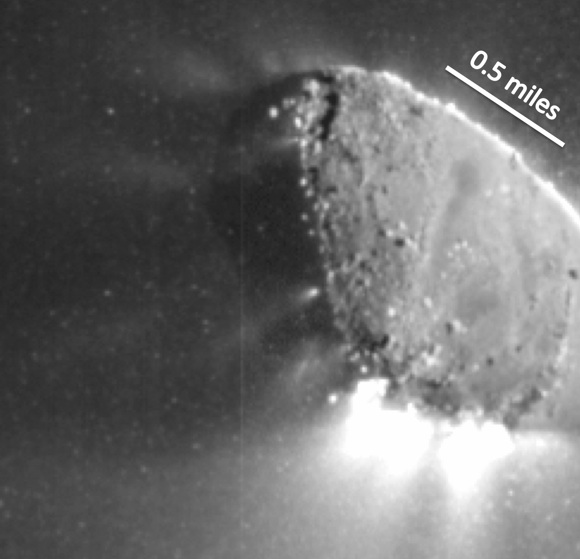This article is more than 1 year old
Comet bomber flyby pics show spaceball belching ancient dry ice
Professor Sunshine bitchslaps wet squirty tail theory
Excellent snaps sent back by a NASA probe craft during a rendezvous with the comet Hartley 2 have revealed that the spectacular "jets" of glowing gas which make it so spectacular result from dry ice subliming in its interior.

A little bit of dry ice fabulousness
NASA's EPOXI* mission has seen the former Deep Impact spacecraft - which successfully bombed the comet Tempel 1 with an impact missile in 2005, gleaning valuable data while so doing - subsequently reassigned to mount a flyby past Hartley 2. During the past five years the probe has carried out cunning gravity-assist flybys past Earth in order to intercept the hurtling comet, and a week ago it zoomed to just 700km from the freezing spaceball. This time, however, there was no impact probe.
This excellent clip from NASA explains:
Since the Hartley 2 intercept last week data has beamed down from the EPOXI craft to NASA's receivers on Earth, and boffins have been eagerly crunching it. Already, traditional notions of how comets work have been upset.
"Previously it was thought that water vapor from water ice was the propulsive force behind jets of material coming off of the body, or nucleus, of the comet," says Professor Jessica Sunshine, who is deputy top boffin for the EPOXI mission.
"We now have unambiguous evidence that solar heating of subsurface frozen carbon dioxide (dry ice), directly to a gas, a process known as sublimation, is powering the many jets of material coming from the comet," continues the prof. "This is a finding that only could have been made by traveling to a comet, because ground based telescopes can't detect CO2 and current space telescopes aren't tuned to look for this gas."
Sunshine and her colleagues believe that it may be commonplace for comets' spurting of gas and dust from their nuclei into their gassy coma, or tail, to be driven by dry ice rather than wet.
"The dry ice that is producing the CO2 jets on this comet has probably been frozen inside it since the formation of the solar system," comments Sunshine's colleague Lori Feaga.
According to the EPOXI pics, Hartley 2's nucleus is peanut or dumbbell shaped, 2km long and 400m across at the narrow point of the neck. The comet-probe boffins expect many more interesting revelations from the probe data, which is still streaming in at a rate of 2,000 images a day.
Many more excellent pics, animations etc can be seen here, courtesy of NASA and Maryland uni where Sunshine and her team work. ®
*Extrasolar Planet Observation and Characterization plus Deep Impact Extended Investigation
